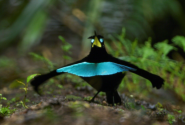By Juliet Eilperin**

Southeast Asia's animals have experienced the most severe hit in recent years, stemming from a combination of agricultural expansion, logging and hunting. ©CIFOR/Aulia Erlangga
A growing number of creatures could disappear from the earth, with one-fifth of all vertebrates and as many as a third of all sharks and rays now facing the threat of extinction, according to a new survey assessing nearly 26,000 species across the globe.
In addition, forces such as habitat destruction, over-exploitation and invasive competitors move 52 species a category closer to extinction each year, according to the research, published online Tuesday by the journal Science. At the same time, the findings demonstrate that these losses would be at least 20 percent higher without conservation efforts now underway.
“We know what we need to do,” said Andrew Rosenberg, senior vice president for science and knowledge at the advocacy group Conservation International and one of the paper’s co-authors. “We need to focus on protected areas, both terrestrial and marine.”
The survey, conducted by 174 researchers from 38 countries, came as delegates from around the world are meeting in Nagoya, Japan, to debate conservation goals for the coming decade.
The researchers analyzed the International Union for Conservation of Nature’s “Red List” – a periodic accounting that classifies mammals, birds, amphibians, reptiles and fish along a spectrum depending on how imperiled they are.
While many industrialized countries have undertaken conservation efforts at home and helped fund this work overseas, “the reality is we’re still exporting degradation across the world” by taking food and other resources from the developing world, according to co-author Nicholas K. Dulvy.
“We’ve transformed a third of the habitable land on earth for food production,” said Dulvy, who co-chairs the IUCN’s shark specialist group. “You can’t just remove that habitat without consequences for biodiversity.”
Southeast Asia’s animals have experienced the most severe hit in recent years, stemming from a combination of agricultural expansion, logging and hunting. Species in parts of Central America, the tropical Andes of South America and Australia have also all suffered significant population declines, largely due to the chytrid fungus killing off amphibians. Forty-one percent of all amphibians are now threatened with extinction.
Norway’s environmental minister, Erik Solheim, who is attending the talks in Nagoya, said in an interview that this sort of accelerating biodiversity loss, coupled with climate change, should compel nations to act boldly: “Very clearly, there’s an increasing sense of urgency here,” he said.
The grim study underscores the failure by parties to the Convention on Biological Diversity to fulfill a 1992 pledge to achieve “a significant reduction in the current rate of biodiversity loss at the global, regional and national level” by this year. The convention’s 193 signatories meeting this month in Japan will set a conservation target for 2020; a U.S. delegation is attending the two-week session even though the United States has not ratified the pact.
Environmental groups are pushing for a goal of protecting 25 percent of all land on earth and 15 percent of the sea by 2020. At the moment, roughly 14 percent of terrestrial areas and less than 1 percent of the ocean enjoy some degree of environmental safeguards.
The new study documents the impact of such policies – 64 vulnerable species have begun recovering due to concerted conservation efforts, the article says. It provides a snapshot of how the world’s birds, mammals and amphibians has evolved over three decades.
Two American species that had become extinct in the wild, the California condor and the black-footed ferret, have both made gains after being reintroduced, while several island species have boosted their numbers after humans took steps to shrink populations of invasive predators that were targeting them. The global population of the Seychelles Magpie-robin, for example, rose from fewer than 15 birds to 180 between 1965 and 2006 after the island’s brown rat numbers came under control.
In some cases, a disparate combination of policies have helped species regain a foothold: the Asian crested ibis went from critically endangered in 1994 to endangered in 2000 due to protection of its nesting trees, controls over chemicals used in nearby rice fields and a prohibition of firearms.
In some instances, policymakers and scientists are just beginning to grapple with the challenges faced by some species – such as sharks, skates and rays. Jack Musick, professor emeritus at the Virginia Institute of Marine Science, helped oversee a global study that suggests roughly 33 percent of cartilaginous fishes are threatened.
Musick, who started studying sharks in the Atlantic a half-century ago and began a shark survey in the Chesapeake Bay and Virginia’s coastal waters in 1973, said he started seeing declines in the 1980s.
While the United States has cut back on shark fishing off its coasts, Musick said, “I can’t say the same for international management.”
Researchers in the IUCN’s shark specialist group made assumptions about the state of some shark species because data is lacking for nearly half of them; they extrapolated what they knew about well-studied species and applied the same ratio of threats to lesser-known ones.
Sonja Fordham, the group’s deputy chair and founder of the D.C.-based Shark Advocates International, said that gaps in data should not hold the world back from protecting sharks. “Around the world, we see similar cases of boom and bust fisheries, and management that is too little, too late,” she said.
*The article was first printed in the Washington Post on 27 October 2010
**Juliet Eilperin is Washington Post Staff Writer
We want you to share Forests News content, which is licensed under Creative Commons Attribution-NonCommercial-ShareAlike 4.0 International (CC BY-NC-SA 4.0). This means you are free to redistribute our material for non-commercial purposes. All we ask is that you give Forests News appropriate credit and link to the original Forests News content, indicate if changes were made, and distribute your contributions under the same Creative Commons license. You must notify Forests News if you repost, reprint or reuse our materials by contacting forestsnews@cifor-icraf.org.










